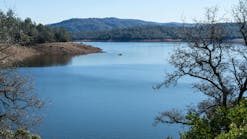Imagine H2O showcases 11 startups shaking up the water industry
On July 26, Imagine H2O showcased 11 innovative water startups, whose unique solutions could one day benefit the water sector.
The startups’ innovations ranged from a geographic information system (GIS) platform and wave-powered desalination to domestic showers with water circulation.
The showcase is part of the Imagine H2O Accelerator Demo Day, where the Accelerator program’s 2023 cohort companies presented 5-minute pitches and answered audience questions.
Imagine H2O is an organization that assists entrepreneurs and startups in the water sector, providing funding, insights and opportunities to help the sector’s adoption of new technologies and solutions.
Imagine H2O Accelerator is one of the group’s development programs. It provides early-stage water startups with resources and support to develop, commercialize and grow their solutions.
The following is a breakdown of the Accelerator program’s 2023 cohort companies and their unique, promising solutions:
Ocean Oasis — Oslo, Norway
Ocean Oasis provides a unique approach to desalination by harvesting the energy of ocean waves for a stable flow of pressurized seawater.
The company is working to provide offshore modular desalination devices, using wave energy to provide water.
Current desalination requires carbon-intensive energy sources, land-intensive operations, and a dedicated brine outlet. With a predicted growing demand for desalination to support water supplies over the coming decades, the solution helps to solve the energy, land, and brine challenges of desalination.
Rather than using electricity, the buoys use a floating oscillating water column to harness pressure from ocean waves. This mechanism can mechanically pressurize seawater to run a reverse osmosis process.
The desalination buoys are positioned up to 5 kilometers from shore. A freshwater line on the ocean bed connects the buoys to a community’s terrestrial water distribution infrastructure. The distance allows for unique advantages over coastal desalination facilities: higher-quality seawater intake and easier brine disposal.
Ocean Oasis plans to build, own and operate the buoys to sell the treated water. The startup’s minimum production capacity is 500 cubic meters, so the solution is geared for larger locations. The company is looking to increase the capacity of existing desalination facilities by working with coastal water utilities.
Ocean Oasis already has established pilots in the Canary Islands, off the west coast of Africa. The startup is also participating in Imagine H2O’s Urban Water Challenge.
Ainwater — Santiago, Chile
Camilo Huneeus, Ainwater’s CEO, discussed the startup’s non-intrusive digital twin of a water treatment plant. The digital twin allows for real-time control and energy optimization. It delivers predictive alerts and specific real-time recommendations for each established operational parameter.
Huneeus said the digital twin had simple instrumentation, a custom dashboard, and predictive models for operational variables — including energy control, chemical dosage, and sludge control.
Ainwater intends to provide its solutions for both utilities and industrial uses. For now, the company is focusing more on the agriculture and food and beverage sectors.
Bluemethane — London, U.K.
Bluemethane captures methane from water to use as a new source of bioenergy and revenue.
Methane emissions from reservoirs and wastewater can contribute significantly to greenhouse gasses. With pressure to reduce emissions and transition to cleaner energy, methane capture can be a powerful solution.
If a wastewater system’s flow has high enough methane concentration, then utilities can capture it, for a source of renewable power or a carbon offset.
Louise Parlons Bentata, Bluemethane’s CEO, described Bluemethane’s system as energy positive with no moving parts.
The methane capture system works by agitating the water to speed up the separation of methane from water. Once captured, the biogas can be upgraded or used on-site.
With low operational expenses and low energy input, the solution could help support the resilience and efficiency of wastewater treatment facilities.
CivilGrid — San Francisco, U.S.
CivilGrid provides a geographic information system (GIS) platform that combines utility, environmental, and geotechnical site data into a single map.
Josh Mackanic, CEO, describes CivilGrid as “Google maps for the underground.”
The platform supports project planning, coordination and design. Its strongest advantages over other GIS systems are its custom workflows and provided site data. CivilGrid comes pre-populated with vetted data on utility lines, land rights, environmental data and more.
Mackanic said that over half the utilities in the state of California are depicted on the platform to date. In the first half of 2023, over 1,000 projects used CivilGrid.
With an approachable user interface, the platform can quickly bring savings for site research costs and reduce delays in a project.
iFlux — Niel, Belgium
The solution uses real-time underground flux sensor networks. The sensors can be installed underground, in the water table. A digital interface communicates where exactly the water is, where it was, and where it’s going.
Stephen Andersen, business development manager for iFlux, said the sensor networks help for pump optimization, relative to availability and risk. It provides a live and predictive defense against contamination with SCADA integration and requires minimal field measurements.
The company is working with four drinking water projects breaking ground throughout 2023 and is also working with industrial clients to monitor groundwater contamination.
LAIIER — London, U.K.
LAIIR’s smart tape leak detection solution uses printed electronics to detect leaks in a building’s pipes in real-time, alerting property managers and owners to reduce the impact of water damage.
The continuous leak monitoring solution aims to help building and facility managers to reduce interruptions, and to help insurers to reduce claims.
The tape allows for clients to monitor for leaks in a wide area at a high resolution — and with a positive return on investment. It also touts easy installation and network deployment.
The smart tape uses patented printed electronics technology, which senses water from leaking assets. The tape can be placed below a pipe, where it will provide an alert to a cloud service if it senses droplets.
The startup is currently limiting its scale and environments of deployment to the facility level, but it has aspirations to scale up to meet utilities’ needs.
Nucleic Sensing Systems — Saint Paul, U.S.
Nucleic Sensing Systems developed an autonomous, portable monitoring tool that virtually reports high-frequency sampling to help monitor and anticipate biological activity.
Ed Rudberg, CEO, called it the world’s first continuous, autonomous droplet digital polymerase chain reaction (PCR) machine.
Named the Tracker, Rudberg likened it to a “biological smoke alarm.” The Tracker can detect targeted species within an hour, can be customized to detect specific organisms, and can detect multiple species at once. Installed Trackers can contribute their sampling data to a geo-temporal software as a service (SaaS) and AI model.
For a price within $100,000, the device provides 24/7 monitoring and ease of use.
The company aims to provide its solution for natural resources management, aquaculture, water and wastewater utilities, and livestock. The solution is currently being used in environmental monitoring. Nucleic Sensing Systems has plans to expand to water and wastewater management.
Sudoc — Cambridge, U.S.
Roger Berry, CEO of Sudoc, called TAMLS “remarkable chemicals that catalyze chemical reactions to make them more efficient, so we can do a lot more with a lot less.”
Berry said that Sudoc’s TAMLs-based solutions could decrease the amount of chemicals, water, and energy required for many intensive operations.
Currently, Sudoc is using its chemicals for a brand of cleaning products, Dilute Oxidation Technology™ (DOT), and water treatment catalysts, New Environmental Approach to Treatment™ (NEAT).
The solutions may be applicable to textile bleaching, pharmaceutical waste removal, wastewater phenol removal, wastewater dye removal, bacterial pathogen removal, and more.
Kairospace Technologies — Las Vegas, U.S.
With agriculture as the primary consumer and polluter of water, the sector faces battles against low quality water and soil degradation.
Juan Bravin, CEO of Kairospace Technologies, said the company’s solution “can enhance the functional properties of water, turning it from a necessity into a tool.”
Bravin said the solution can boost crop yields, control pests, enhance seed germination rates, and raise fresh produce shelf lifespans. He said it also can sequester more carbon into the soil, reduce salt compaction, improve soil aeration, and eliminate ammonia from wastewater.
“We make plants grow larger, faster, and more nutritious,” said Bravin.
The system processes water with ultrafine bubbles, water conditioning, advanced oxidation processes, and plasma activation.
OmniVis — San Francisco, U.S.
OmniVis’s iSpyDx™ is a hand-held testing device that detects pathogens.
Katherine Clayton, CEO and founder, said the device can detect pathogens like E. coli within 30 minutes.
The company is first looking to expand its solution to food processing facilities. These facilities test surfaces and water every week, but the tests have a 3-day turnaround time — meaning a food recall could cost the facility millions.
iSpyDX™ performs particle diffusometry tests on environmental samples to detect contamination. It currently detects E. coli, and the startup plans to be able to test for Listeria and Salmonella next.
The testing procedures requires swabbing on a surface, which is added to a single-use disposable test kit. Each kit would be able to test for a particular pathogen of interest. These kits are added to the iSpyDX™ testing device. The test results can be uploaded to a cloud dashboard, and then managers can use cumulative test result data to evaluate risk.
OmniVis’s prices are expected to be $1,000 for the hardware device, $10 for disposable test kits, and $25 monthly for the cloud dashboard service.
Though the company is looking to target food processing facilities first, it is also keeping its eyes on adjacent opportunities, like water and wastewater treatment, as well as agriculture.
RainStick — Kelowna, Canada
The RainStick is a domestic shower installation, providing a shower system that captures, circulates, and cleans water for reuse.
Alisha McFeltridge, cofounder and CEO
In the U.S. today, 10-minute shower can use 25 gallons of water.
“This is not only wasteful from a water and an energy perspective, but it’s also really expensive,” said Alisha McFeltridge, RainStick CEO.
The RainStick intends to save the water equivalent of a whole graywater system without the need for complex installation. McFeltridge called the solution “a system that saves 80% water and up to 80% energy while providing double the flow rate.”
The low-maintenance system passes the used water through an internal system, passing through a micron screen, efficient pump, high-intensity UV-C LED treatment, hot and cold water inlet, and electronic thermostatic mixer.
RainStick currently supports a standard installation for tiled surfaces. The startup has plans to debut a new 1-day installation option over the next few months.















